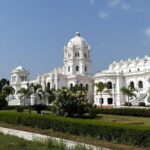Brahmanbaria District: A Hub of Culture, History, and Trade in Bangladesh
 Brahmanbaria District: A Hub of Culture, History, and Trade in Bangladesh-
Brahmanbaria District: A Hub of Culture, History, and Trade in Bangladesh-
Brahmanbaria District, located in eastern Bangladesh, is known for its rich history, vibrant culture, and economic significance. It has been a center for trade, education, and arts for centuries.
In this blog, we will explore the history, geography, culture, economy, and major attractions of Brahmanbaria District.
History of Brahmanbaria District-
Brahmanbaria has a long and significant history. The district played a key role in the anti-British movement and the Liberation War of 1971. It was established as a separate district in 1984.
It is home to renowned personalities like Ustad Alauddin Khan, a maestro of classical music, and was an important location for cultural and political movements.
Geography and Climate-
Brahmanbaria District is situated in the eastern part of Bangladesh and shares borders with:
- Comilla
- Habiganj
- Kishoreganj
- Narsingdi
- Tripura (India)
The district has a tropical monsoon climate with distinct summer, monsoon, and winter seasons. Major rivers include the Meghna and Titas, which play a crucial role in transportation and agriculture.
Culture and Heritage-
Brahmanbaria is a cultural hub in Bangladesh. It has a strong presence of traditional music, literature, and arts.
Notable Cultural Aspects-
- Classical Music: Ustad Alauddin Khan’s legacy continues to inspire musicians.
- Folk Traditions: The district is famous for Baul and Bhatiali songs.
- Religious Harmony: It is home to diverse religious communities with significant mosques, temples, and shrines.
Economy and Livelihood-
Brahmanbaria’s economy is diverse, including agriculture, industry, and trade. The district is well known for:
- Agriculture: Rice, jute, and vegetables are widely cultivated.
- Industries: Brickfields, textiles, and food processing industries contribute significantly.
- Trade and Commerce: The Akhaura land port facilitates cross-border trade with India.
Top Tourist Attractions in Brahmanbaria District-
Brahmanbaria offers various attractions for travelers interested in history, nature, and culture.
1. Kazi Mahmud Shah Mosque
A historical mosque dating back to the Mughal era, known for its intricate architecture.
2. Alauddin Khan Music Academy
A center dedicated to the legacy of Ustad Alauddin Khan, where classical music is promoted and taught.
3. Akhaura Land Port
One of Bangladesh’s busiest land ports, playing a vital role in trade with India.
4. Titas River
A scenic river that inspired numerous songs and literary works, ideal for boat rides and sightseeing.
5. Haripur Zamindar Bari
An ancient palace reflecting the rich history of the region’s zamindars.
Transportation and Accessibility-
Brahmanbaria is well-connected by road, rail, and waterways:
- Roadways: Direct bus services are available from Dhaka, Chattogram, and Sylhet.
- Railways: The Dhaka-Chattogram railway line passes through Brahmanbaria.
- Waterways: The Meghna and Titas rivers support local transport and trade.
Future Development Plans-
The district is undergoing rapid infrastructure development, with new highways, educational institutions, and industrial zones being established to boost economic growth.
Conclusion-
Brahmanbaria District is a perfect blend of history, culture, and economic prosperity. Whether you’re interested in exploring historical sites, experiencing traditional music, or engaging in trade, Brahmanbaria offers something for everyone.
Frequently Asked Questions About Brahmanbaria District-
1. Where is Brahmanbaria District located?
-Brahmanbaria District is in eastern Bangladesh, bordering Tripura, India.
2. What are the main economic activities in Brahmanbaria?
– Agriculture, industry, and trade are the primary economic activities in the district.
3. What are the major tourist attractions in Brahmanbaria?
-Popular attractions include Kazi Mahmud Shah Mosque, Alauddin Khan Music Academy, Titas River, and Haripur Zamindar Bari.
4. How can I travel to Brahmanbaria?
-You can reach Brahmanbaria by bus, train, or river transport from various parts of Bangladesh.
5. Why is Brahmanbaria culturally significant?
-Brahmanbaria has a rich cultural heritage, especially in classical music and literature, and is home to historical sites and traditional art forms.